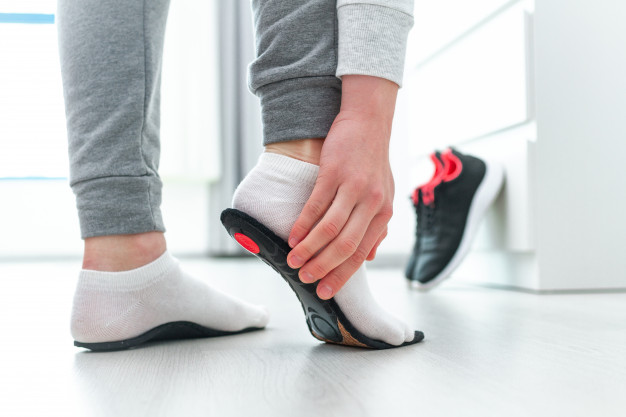Flat foot, flat feet, or pes planus is a postural defect relating to the collapse or flattening of the medial longitudinal arch. The condition is most often inherited but can occur in adulthood too. Although there are varying degrees of the collapse, people are still able to live absolutely pain-free with flat feet.
Types of Flat Foot.
Flexible Flat FootThe most common type, flexible flat foot involves the arches in your feet to appear only while you lift them off the ground. And, your soles touch the ground entirely when you place your feet on the ground.
This type begins in childhood and is usually painless.
Short Achilles Tendon
Your Achilles tendon links your heel bone to your calf muscle. If it’s extremely short, you might experience pain while you walk or run. This condition causes the heel to lift prematurely during the above-mentioned activities.
Posterior Tibial Tendon Dysfunction
This type is attained in adulthood when the tendon that connects your calf muscle to the inside of your ankle is injured, swollen, or torn. If your arch is void of the support it needs, you’ll have pain on the inside of your foot, and on the exterior of the ankle.
What Causes Flat Foot?
This condition can be congenital (e.g. from birth) or acquired (e.g. adults, increased exposure to weight-bearing).
Congenital Flat Feet: They occur when someone is born with or susceptible to a more flexible midfoot region resulting in pronation or collapsing of the arch.
Acquired Flat Feet: These are caused by a loss of active (e.g. intrinsic foot and ankle stabilizers) or passive support (ligamentous negligence, hypermobile joints) during vigorous weight-bearing activities. Muscular insufficiency in the ankle and arch stabilizers are the most common factor for flat feet.
Who Is at Risk?
You’re more likely to ail from it if the condition runs in your family. Or if you’re greatly athletic and physically active, your risk increases due to any future foot and ankle injuries. Older people who are prone to falls or physical injury are also at risk.
Others with diseases that affect the muscles, like cerebral palsy, also have a bigger risk. Many other risk factors include obesity, rheumatoid arthritis, hypertension, and diabetes mellitus.
Recognizing Symptoms.
Most people have no signs or symptoms associated with flat feet. But some people with flatfeet experience the following:
• Foot pain, particularly in the heel or arch area.
• Pain may get worse with activity.
• Swelling along the inside of the ankle can also occur.
Flat Feet Treatment.
If your flat feet are painful, your doctor might suggest:
Arch Supports: Over-the-counter arch supports may help relieve the pain caused by flat feet. Or maybe custom-designed arch supports, shaped to the outlines of your feet. Arch supports often reduce symptoms.
Stretching Exercises: Some people with flat feet also have a reduced Achilles tendon. Exercises to stretch this tendon may help.
Physical Therapy: Flat feet may contribute to overuse injuries in some runners. A physical therapist can do a video analysis of how you run to help you improve your form and technique.
Lifestyle Changes: Reducing pain from flat feet may require integrating some changes in your daily routine. For example, introducing yourself to a prescribed diet and exercise program for weight loss to reduce the pressure on your feet. You may also be advised to not stand or walk for elongated periods.
Medication: In order to minimize the discomfort from the troubling symptoms, your doctor might prescribe you medication. Nonsteroidal anti-inflammatory medicines can relieve swelling and pain.
Foot Surgery: Surgery may be the last resort in many cases and is usually results in a positive outcome. Your orthopedic surgeon may create an arch in your feet, repair tendons, or fuse your bones or joints. If your Achilles tendon is too short, the surgeon can lengthen it to decrease your pain.
Preventing Flat Feet.
Flat feet are usually inherited and can’t be prevented. But, you can prevent the worsening excessive pain by taking precautions such as wearing shoes that fit well and provide the necessary foot support.

